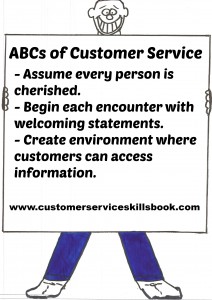Delivering Positive Customer Service Every Time
With regular access to products and services from around the world, consumers no longer use cost as their single determining factor when making a buying decision. They look at other factors like delivery policy and times, quality, and levels of service received. Often, the deciding factor for some people is how well they are treated and if their needs are truly considered and met by service providers. The key to transforming visitors into loyal customers is for every employee at all levels of the organization to take ownership of each customer encounter.
Follow the ABCs of customer service for more effectively serving potential and returning customers.
Assume that every person with whom you come into contact is a cherished customer or potential customer and make them feel as such.
Begin each encounter with statements that make the person feel welcome and that you are truly there to assist them in whatever ways possible.
Create an environment on the telephone, via the Internet and in-person in which customers can access the information that they need to answer questions, educate them, and aid in making an informed buying decision.
For more ideas on effectively creating an environment that encourages customer and brand loyalty, get copies of Customer Service Skills for Success, How to Be a Great Call Center Representative and Please Every Customer: Delivering Stellar Customer Service Across Cultures.
About Robert C. Lucas
Bob Lucas has been a trainer, presenter, customer service expert, and adult educator for over four decades. He has written hundreds of articles on training, writing, self-publishing, and workplace learning skills and issues. He is also an award-winning author who has written thirty-seven books on topics such as, writing, relationships, customer service, brain-based learning, and creative training strategies, interpersonal communication, diversity, and supervisory skills. Additionally, he has contributed articles, chapters, and activities to eighteen compilation books. Bob retired from the U.S. Marine Corps in 1991 after twenty-two years of active and reserve service.
Make Money Writing Books: Proven Profit Making Strategies for Authors by Robert W. Lucas at Amazon.com.
The key to successfully making money as an author and/or self-publisher is to brand yourself and your company and to make yourself and your book(s) a household name. Part of this is face-to-face interaction with people at trade shows, library events, book readings, book store signings, blogging or guest blogging on a topic related to their book(s). Another strategy involves writing articles and other materials that show up online and are found when people search for a given topic related to a topic about which the author has written.
If you need help building an author platform, branding yourself and your book(s) or generating recognition for what you do, Make Money Writing Books will help. Bob’s popular book addresses a multitude of ideas and strategies that you can use to help sell more books and create residual and passive income streams. The tips outlined in the book are focused to help authors but apply to virtually any professional trying to increase personal and product recognition and visibility.


